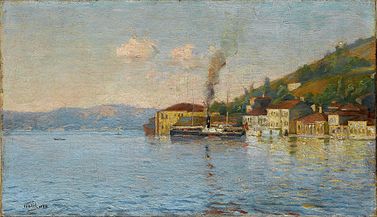Halil Pasha (painter)
Halil Pascha , also Halil Bey , Halil Paşa , actually Khalîl , (* in the 1850s in Istanbul ; † August 1939 there ) was a Turkish painter. He is considered one of the first Turkish impressionists .
Life
Halil Pasha's family came from the island of Rhodes . His father Selim was one of the founders of the Kara Harp Okulu Military Academy .
Like many painters interested in Western art in Turkey, he received training in technical drawing and painting at the "Mühendishane-i Berrî-i Hümâyûn" (Military School of Engineering, now the Istanbul Technical University). At that time, painting was part of the Ottoman officer's training to train people to see and observe closely.
During the final exams, students were usually hired to teach military schools, but Halil Pasha insisted on continuing his education in Paris. In 1880 his father agreed and Halil Pascha studied painting at the École des Beaux-Arts in the French capital. He worked for many years in the studios of Jean-Léon Gérôme and Gustave Courtois . He presented his work to a larger audience for the first time at the Paris World's Fair in 1889 and immediately won a bronze medal.
After returning to Turkey in 1889, he became a teacher at a military school. At the World Exhibition in Paris in 1900, he exhibited in both the Grand Palais and the Ottoman Pavilion. His works were also shown regularly in the Constantinople Salon.
In 1906 he received the title of pasha . Two years later, during the beginning of the second Ottoman constitutional period , he decided to retire with the rank of colonel and become a private tutor. Later he also taught at the "Sanayi-i Nefise Mekteb-i Alisi" (German Academy of Fine Arts and Crafts , today Mimar Sinan Üniversitesi ) and was Rector there from 1917 to 1918.
During the Turkish War of Liberation he went to Egypt at the invitation of Abbas II , the last Khedive . After his return, he lived for a long time as a guest in the Istanbul Palace of the Khedive and maintained a studio there.
plant
In contrast to contemporary Ottoman painters such as Osman Hamdi Bey , who represented a strongly academic painting, Halil Pascha was a staunch impressionist. What was new for Turkey was painting from nature outside of the studio. He was influenced by the Barbizon School and Impressionism . His preferred subjects were pictures of the lake, city and coast views and motifs from fishing life. The works are strongly influenced by mood and atmosphere.
Halil Pascha is considered one of the most important painters of the turn of the century in Turkey. He was the first of the so-called "soldier painters" who, as an officer, devoted himself exclusively to painting.
painting
The following paintings are on display at the Sakıp Sabancı Müzesi in Istanbul :
Çengelköy - Iron Bridge on the Bosporus (1890)
Exhibitions
- 2009: Travel to the West - 70 Years of Turkish Painting (1860–1930). Sakıp Sabancı Müzesi , Istanbul
- 2011: While a Country is changing - Turkish Painting from the Ottoman Reformation to the Republic , Sakıp Sabancı Müzesi, Istanbul
- 2018: Color Light Vibration - Turkish Impressionists. Arkas Sanat Merkezi, Izmir
literature
- Ernst Kühnel : Halil Pascha . In: Ulrich Thieme , Fred. C. Willis (Ed.): General lexicon of visual artists from antiquity to the present . Founded by Ulrich Thieme and Felix Becker . tape 15 : Gresse – Hanselmann . EA Seemann, Leipzig 1922, p. 504 ( Textarchiv - Internet Archive ).
- Halil Pasha (painter) . In: General Artist Lexicon . The visual artists of all times and peoples (AKL). Volume 68, de Gruyter, Berlin 2010, ISBN 978-3-598-23035-6 , p. 189.
- Taha Toros: Halil Paşa In: Dergisi Antique Decor. Antikalar, No. 45, pp. 70–78 ( antikalar.com )
Web links
Remarks
- ↑ Different sources name different years of birth. These range from 1852 to 1853 and 1857 to 1859. According to Taha Toros (see literature), Halil Pascha gave his date of birth in his records as 1857, although 1852 is mentioned as the date of birth in his passport.
Individual evidence
- ↑ a b c Halil Pasha , turkishpaintings.com.Retrieved April 2, 2018.
- ↑ a b c d e Ernst Kühnel : Halil Pascha . In: Ulrich Thieme , Fred. C. Willis (Ed.): General lexicon of visual artists from antiquity to the present . Founded by Ulrich Thieme and Felix Becker . tape 15 : Gresse – Hanselmann . EA Seemann, Leipzig 1922, p. 504 ( Textarchiv - Internet Archive ).
- ↑ a b "Halil Paşa'nın En Pahalı 20 Resmi" , Lebriz.com, accessed April 2, 2018
- ↑ Exhibition website, Sakıp Sabancı Museum, accessed on May 30, 2018 (English).
- ↑ Turkey's transformation as told through art , Hürriyet Daily News, December 27, 2011 (English)
- ^ Exhibition page, Arkas Sanat Merkezi, accessed on May 30, 2018 (English).
| personal data | |
|---|---|
| SURNAME | Halil Pasha |
| ALTERNATIVE NAMES | Khalîl, Halil Bey; Halil Paşa |
| BRIEF DESCRIPTION | Ottoman painter |
| DATE OF BIRTH | 19th century |
| PLACE OF BIRTH | Istanbul |
| DATE OF DEATH | August 1939 |
| Place of death | Istanbul |




